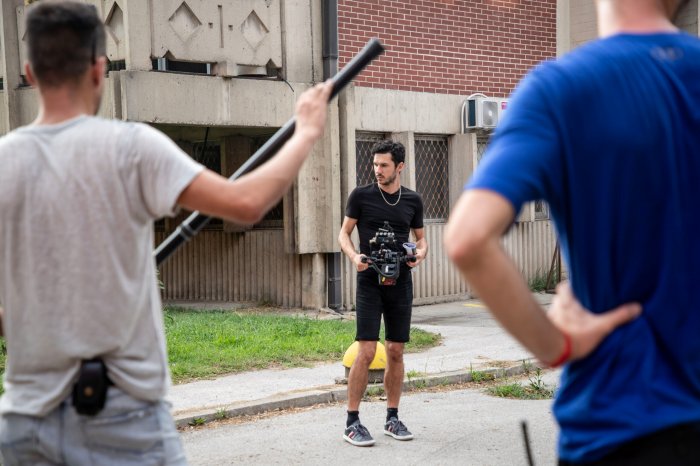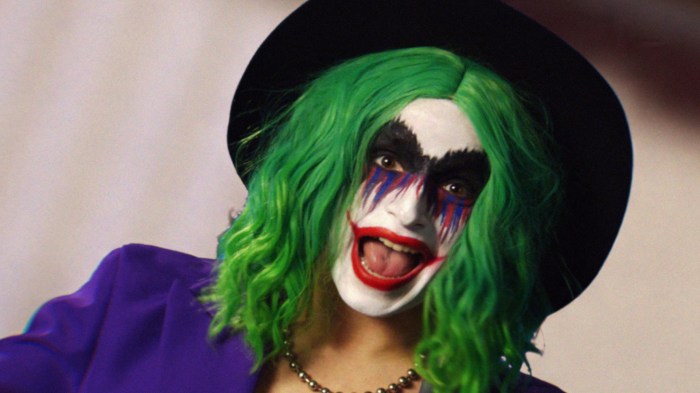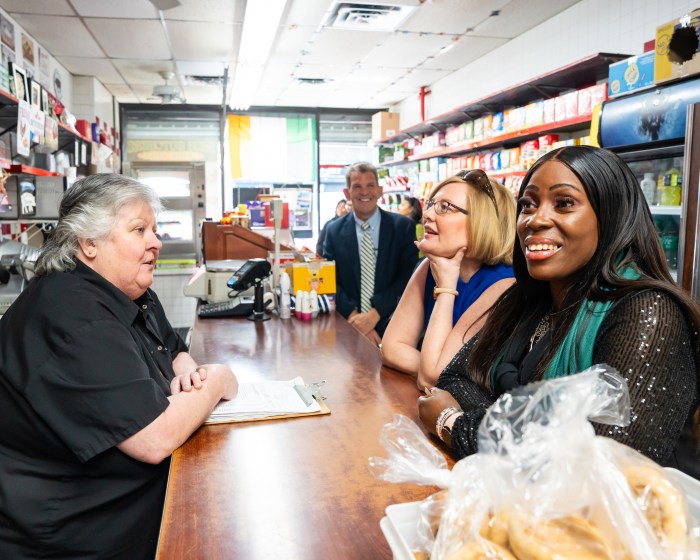Tribeca sculptor conceives armor as empowering corrective
Upon meeting Tribeca sculptor Linda Stein for the first time, one is struck by the contrast of her no-nonsense New York spunk and the genuine warmth of her personality.
Stein was hosting a book party at her intimate Reade Street gallery. In a low-key, approachable style, she gave the guests a brief introduction of the original and compelling art work that hung on her walls—which consisted of life-size feminine torsos made of brass, copper, sheet metal and wood or paper. Some were minimalistic in both form and matter, made from organic materials like stone, bone and beech wood; others, richly bejeweled and mixed into a hodgepodge of objects drawn from the everyday matter of post-industrial life and spiritual, archetypal textual matter and imagery. She called the sculpture series female knights of protection.
Stein, who was born and raised in the Bronx and seems as comfortable wielding heavy machinery as she is handling delicate parchment paper, is hardly the image of stereotypical feminine vulnerability. Sacha Baron Cohen was quick to find this out the hard way by inviting her to participate in a bogus panel on third world women’s rights for his film and title role, “Borat.” When Stein caught on to the travesty, she let Baron Cohen have it and stormed off the panel.
And yet, it was her sense of dire vulnerability (experienced during the 9-11 attacks on the World Trade Center) that took her in a new and unexpected direction — from abstract to figurative sculptor.
Stein, whose studio-gallery is located at a stone’s throw away from Ground Zero, was already at work when the planes attacked the Twin Towers. Upon hearing the sounds of the crashes, she and a few of her assistants ran northward holding hands to escape from what Stein mistakenly thought was a bomb attack on the towers.
At the time, she also ran a premiere calligraphy business above her gallery and had been a Tribeca resident since the late seventies — but was forced to relocate to the Upper-East side for eight months. Even though the traumatic experience prevented her from sculpting for a full year, the artist was determined to return to Tribeca.
She explained that what initially attracted her to the neighborhood three decades ago was the fact that it had many artists, lofts and wasn’t yet commercialized. “Tribeca now has thousands of artists living in its lofts and apartment spaces,” Stein observes. “So many celebrities. There are more theaters and performance spaces, and even restaurants catering to artists.” As for the Tribeca art scene, Stein weighs in on the gender element: “With so many experimental artists here, I would guess/hope that, as a demographic group, we are more open to gender fluidity and less prone to stereotypes and sexism than in more conservative neighborhoods.”
Evaluating the relative merits of the Tribeca art scene shows how far the area has come since Stein first contemplated moving here — when a cop helped her overcome concerns about the gritty and still largely under-populated area. Stein recalls the policeman telling her, “Lady, there’s nobody here, it’s the safest place around.” Even though the neighborhood has significantly gentrified since then, Stein still loves it because of the large art scene and the liberal mindset.
When Stein returned to making art after 9/11, she soon discovered the need to confront fears with symbols of empowerment. Describing her creative process as being in the driver’s seat (but as the chauffeur, not always as the conscious and willful driver), she noted that while her previous subjects were abstract in character and mostly horizontal in form, her new sculptures began to take on vertical forms and to resemble human-like figures in armor.
A passionate feminist and a member of the respected Veterans of Feminists of America organization, Stein had strong reactions to what she terms as the post-9/11 masculinization of war by the Bush administration and expresses these in her art. She was appalled by the gender-stereotyping in portrayal of heroes and victims in the media and among those in political office.
The male images of 9/11 were predominately those of strong, sacrificing heroes, while the female faces of the attacks consisted almost exclusively of the 9/11 victims and widows. It was as though the service and valor of the hundreds of female first response workers who had risked their lives and rescued the lives of many received virtually no recognition, let alone the celebratory gratitude that was directed to their male counterparts, Stein explained.
Stein’s sculpted armor is conceived in part as a corrective to this. Though, it initially troubled her at first that her sculptures seemed to invoke militancy (Stein has been a life-long pacifist), she came to realize that the power expressed by her knights was not about violence or bravado, but about strength and empowerment. The knights did not contradict peace; rather, they create a relationship of compassion between the armored and those they seek to protect. As Stein expanded on this idea of armor bestowing the positive qualities of safety and valor, she began to bring powerful, female non-violent icons from her childhood, such as Wonder Woman. Eventually, the invocation of female power in Stein’s work extended beyond the popular super-heroine to include the Japanese anime character Princess Mononoke and the Japanese goddess of justice and compassion, Kannon.
But irrespective of whichever powerful, peaceful icons Stein summons into her sculptural pantheon, what seems to matter most to the artist and gender activist is introducing a new paradigm of protection: one that is peaceful, empowering and transcends gender.
In recent years, she has been exploring direct, interactive contact between her art and the public. Fascinated by the possibilities of tricking the body by optical and sensory illusions and the empowering psychological states that can be generated by them, Stein has been designing her sculptures to be both displayed and worn. She also hopes her armor will be worn and experienced as a possibility to escape the male-female binary and experience more the fluidity of gender.
Most recently, the sculptor has been inviting the public, men and women alike to don her armor, dance in it and experience it as a second skin. Stein aptly calls this experience “body-swapping.” She explains: “By wearing my sculptural knights, men and women can body swap genders and personas, feeling empowered and expansive.”
At a recent body-swapping event, dancer Josie M. Coyoc (of Pilobolus Dance Company) performed a graceful, ritual-like dance to hypnotic Oriental rhythms as she wore Stein’s sculptures and carried a scepter in both hands. Coyoc seemed at one with the armor and moved as though she deeply identified with the powers of the icons she was wearing.
Later, the women and men at the party began to try on the armor. Some moved around sheepishly at first, while others immediately abandoned themselves to the feelings and experience of standing taller, wider and harder. Others still were happy to simply enjoy the sensory experience of the armor and moved as though the armor liberated them to dance and move expressively.
Besides admiring the aesthetic beauty of Stein’s sculptures, Coyoc admitted to wanting to own one of Stein’s sculptures for practical reasons as well: “I want to own one so that I can put it on when I need to give a difficult speech or ask for a raise and have no problem asking for what I want. And I’d probably get it too.”
So, if you’re looking to experience what it’s like to have someone have your back, Stein’s got you covered.
Stein’s art and armor can be experienced at her 200 Read Street gallery, year-round, by appointment. For upcoming showings and events, visit her website at http://lindastein.com.

































